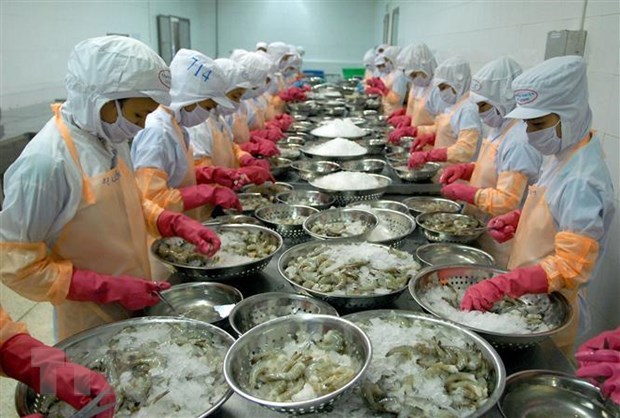Shrimp businesses invest in long-term development
Thứ Bảy, 20/03/2021, 17:45
Having posted double-digit growth last year despite COVID-19 and with opportunities stemming from new-generation free trade agreements, many shrimp enterprises have been investing in building processing facilities and raw material areas for their long-term development.
 |
|
Processing shrimps for export (Photo: VNA) |
Having posted double-digit growth last year despite COVID-19 and with opportunities stemming from new-generation free trade agreements, many shrimp enterprises have been investing in building processing facilities and raw material areas for their long-term development.
Expanding processing plantsMajor players such as the Thuan Phuoc Seafood & Trading Corp., the Minh Phu Seafood Corp., and the Nha Trang Seafood Company have kicked off expansion efforts since the beginning of the year, all in the Mekong Delta.
Thuan Phuoc has opened its 400 billion VND (17.45 million USD) An An shrimp processing plant in Tien Giang province, with a capacity of some 50 tones of finished shrimp products a day.
Minh Phu, meanwhile, is preparing to begin the construction of two large-scale processing plants, costing close to 1 trillion VND and with a combined annual capacity nearing 50,000 tones, in Hau Giang and Ca Mau provinces. The corporation is also eyeing the construction of another factory in nearby Kien Giang province.
Nha Trang Seafood is completing the final steps to put a processing plant into operation in Bac Lieu province, which will be capable of producing 10,000 tones of products annually.
Last year, Sao Ta Foods JSC invested nearly 400 billion VND in simultaneously building two shrimp processing plants in Soc Trang province’s An Nghiep Industrial Park. The two boast a capacity of 20,000 tones a year.
Ho Quoc Luc, Chairman of the Sao Ta Board of Directors, said the shrimp sector’s expansion in Soc Trang has seen the engagement of not only large enterprises but also new players.
If the sector maintains its current growth momentum, it will take the lead globally in a couple of years, he added.
Developing sustainable material areas
A draft fisheries development strategy to 2030 and vision to 2045, developed by the Ministry of Agriculture and Rural Development, targets the sector contributing 28-30 percent of national GDP by 2030. Total aquatic output is to reach 10 million tones, of which aquaculture output is to account for 70-75 percent. This will be a driving force for businesses to invest in expanding raw material farming areas.
At the “Dialogue 2045” program chaired by Prime Minister Nguyen Xuan Phuc on March 6, director general of Minh Phu Seafood Le Van Quang said that to ensure sustainable material sources, his corporation has devised a plan on smart and green value chain development that consists of different shrimp farming models suitable to different localities. It has also developed an AI- and blockchain-based mobile phone app to manage shrimp farms.
With the development of sustainable shrimp production models, he went on, Vietnam will be capable of becoming the world’s No. 1 shrimp production and processing powerhouse, holding a market share of 25 percent globally and producing nearly 4 million tones of raw shrimp by 2045.
Thuan Phuoc, meanwhile, is developing a 200-ha shrimp farming area in Ben Tre province.
Chairman of its Board of Directors Tran Van Linh said it aims to expand its investment in farming and processing to the north of the Hau River, turning it into a key material area and proactively controlling food safety standards to meet its sustainable development goals.
VNA

